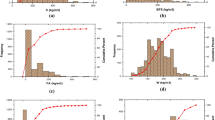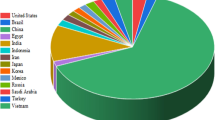Abstract
This paper presents the TOPSIS (technique for order preference by similarity to Ideal solution) method to determine the optimal mix proportions of bagasse ash blended high performance concrete (HPC). This method is used to combine all experimentally identified performance criteria of the system into single value, which can be utilized as distinct performance in the multi-criteria optimization problems. In this study, five types of proportions were selected as alternatives and fifteen different test data as criteria. The performance criteria are categorized into three parameters (1) mechanical properties: compressive strength, splitting tensile strength, flexural strength, modulus of elasticity, poison’s ratio (2) workability properties: slump value and air content (3) durability properties: saturated water absorption, porosity, sorptivity, alkalinity measurement (pH), impact strength, drying shrinkage, sea water resistance and acid resistance. The required data for formulating decision matrix are obtained from experimental study carried out on mechanical, workability and durability properties of high performance concrete. TOPSIS method is then used to reduce multiple-criteria performance into single value based on ranking to smooth the progress of decision-making process. Later on, the alternatives were ranked and the optimum mix proportions were obtained.


Similar content being viewed by others
Availability of data and materials
The authors confirms that all the supporting data are available in manuscript.
Code availability
Not applicable.
References
Hwang CL, Yoon K (1981) Multiple attribute decision making: methods and applications. Springer, New York
Caterino N, Iervolino I, Manfredi G, Cosenza E (2008) Multi-criteria decision making for seismic retrofitting of RC structures. J Earthq Eng 12(4):555–583
Caterino N, Iervolino I, Manfredi G, Cosenza E (2009) Comparative analysis of multi-criteria decision making for seismic structural retrofitting. Comput Aided Civ Infrastruct Eng 24(6):432–445
Lan TS (2009) Taguchi optimization of multi objective CNC machining using TOPSIS. Inf Technol J 8(6):917–922
Su T-L, Chen H-W, Lu CF (2010) Systematic optimization for the evaluation of the microinjection molding parameters of light guide plate with TOPSIS based Taguchi method. Adv Polym Technol 29(1):54–63
Wang T, Chuan Xin B (2011) Thermal power plant sitting based on TOPSIS method. Proc Eng 15:5384–5388
Hong G-B, Su T-L (2012) ‘Statistical analysis of experimental parameters in characterization of ultraviolent–resistant polyester fiber using a TOPSIS–Taguchi method.’ Iran Polym J 21(12):877–885
Lu JC, Yang T, Su CT (2012) Analyzing optimum push/pull junction point location using multiple criteria decision making for multistage stochastic production system. Int J Prod Res 50(19):5523–5537
Turkmen I, Gul R, Celik C, Demirboga R (2003) Determination by Taguchi method of optimum conditions for mechanical properties of high strength concrete with admixture of silica fume and blast furnace slag. Civ Environ Syst 20(2):105–118
Yousefi A, Sahamad MS, Amajid T (2014) Application of TOPSIS method in prioritization of highway bridges for seismic retrofitting. Eng Struct Technol 6(3):114–123
Anna KRAWCZYNSKA-PIECHNA (2015) ‘Application of TOPSIS method in formwork selection problem’. Appl Mech Mater 797:101–107
Kittur J, Poornanand UC, Pavankumar MP, Reddy P, Patil PR (2016) Optimal generation evaluation by TOPSIS method. In: Biennial international conference on power and energy systems: towards sustainable energy
Alptekin O, Alptekin N (2017) Analysis of criteria influencing contractor selection using TOPSIS method. Mater Sci Eng 245:0620003
Keshtkar MM (2017) Performance analysis of a counter flow wet cooling tower and selection of optimum operative condition by MCDM-TOPSIS method. Appl Therm Eng 114:776–784
Balioti V, Tzimopoulos C, Evangelides C (2018) Multi-criteria decision making using TOPSIS method under fuzzy environment. Application in spillway selection. Multidiscip Digit Publ Inst Proc 2:637
Zhang X, Zhang Q, Sun T, Chen H (2018) Evaluation of urban public transport priority performance based on the improved TOPSIS method: a case study of Wuhan. Sustain Cities Soc 43:357–365
Yang K, Xu K, Lian J, Ma C, Bin L (2018) Integrated flood vulnerability assessment approach based on TOPSIS and Shannon entropy methods. Ecol Ind 89:269–280
Ramnath RA, Thyla PR, Kumar NM, Aravind S (2018) Optimization of machining parameters of fibre matrix composites using multi attribute decision making techniques: a review. J Reinf Plast Compos 37(2):77–89
Hinislioglu S, Bayrak OU (2004) Optimization of early flexural strength of pavement concrete with silica fume and fly ash by the Taguchi method. Civ Environ Syst 1(2):79–90
Narendra H, Muthu KU, Al-Mattarneh H, Naidu NVR, Sowmya BS (2008) Optimization of self compacting concrete mixes using Taguchi method. ICCBT-A 17:191–204
Ozbay E, Oztas A, Baykasoglu, Ozbebek H (2009) Investigating mix proportions of high strength self compacting concrete by using Taguchi method. Constr Build Mater 23:694–702
Turkmen I, Gul R, Celik C (2008) A Taguchi approach for investigation of some physical properties of concrete produced from mineral admixtures. Build Environ 43:1127–1137
Chang CY, Huang R, Lee PC, Weng TL (2011) Application of a weighed grey-Taguchi method for optimizing recycled aggregate concrete mixtures. Cem Concr Compos 33:1038–1049
Olivia M, Nikraz H (2012) Properties of fly ash geopolymer concrete designed by Taguchi method. Mater Des 36:191–198
Simsek B, Ic Y, Simsek EH (2013) A TOPIS based Taguchi optimization to determine optimal mixture proportions of the high strength self-compacting concrete’. Chemom Intell Lab Syst 125:18–32
Rahim A, Sharma UK, Murugesan K, Sharma A, Arora P (2013) Multi-response optimization of post-fire residual compressive strength of high performance concrete. Constr Build Mater 38:265–273
Joshaghani A, Ramezanianpour AA, Golroo A (2015) Optimizing pervious concrete pavement mixture design by using Taguchi method. Constr Build Mater 101:317–325
Simsek TB, Ic Y, Simsek EH (2016) A RSM based multi response optimization application for determining optimal mix proportions of standard ready mixed concrete. Arab J Sci Eng 41(4):1435–1450
Praveenkumar S, Sankarasubramanian G, Sindhu S (2019) Selecting optimized mix proportion of HPC blended with bagasse ash using analytical hierarchy process (AHP). Comput Concr 23(6):459–470
Kelestemur O, Arici E, Yildiz S, Gokceri B (2014) Performance evaluation of cement mortars containing marble dust and glass fibre exposed to high temperature by using Taguchi method. Constr Build Mater 60:17–24
Panagiotopoulous C, Tsivilis S, Kakali G (2015) Application of the Taguchi approach for the composition optimization of alkali activated fly ash binders. Constr Build Mater 91:17–22
Simsek B, Uygunoglu T (2016) Multi response optimization of polymer blended concrete: a TOPSIS based Taguchi application. Constr Build Mater 117:251–262
Tanyildizi H, Sahin M (2015) Application of Taguchi method for optimization of concrete strengthened with polymer after high temperature. Constr Build Mater 79:97–103
Shanmugam P, Gopalan S (2020) Effect of fibers on strength and elastic properties of bagasse ash blended HPC composites. J Test Eval 48(2):922–937
Ic YT (2012) An experimental design approach using TOPSIS method for the selection of computer-integrated manufacturing technologies. Robot Comput Integr Manuf 28(2):245–256
Aitcin PC (1988) High performance concrete. CRC Press
Praveenkumar S, Sankarasubramanian G, Sindhu S (2020) Strength, permeability and microstructure characterization of pulverized bagasse ash in cement mortars. Constr Build Mater 238:117691
Praveenkumar S, Sankarasubramanian G (2019) Mechanical and durability properties of bagasse ash-blended high-performance concrete. SN Appl Sci 1:1664
Srinivas D et al (2021) Experimental characterization of quaternary blended mortar exposed to marine environment using mechanical strength, corrosion resistance and chemical composition. J Build Eng. https://doi.org/10.1016/j.jobe.2021.102822
Vali SK, Murugan BS, Reddy SK, Farsangi EN (2020) Eco-friendly hybrid concrete using pozzolanic binder and glass fibers. Int J Eng. https://doi.org/10.5829/ije.2020.33.07a.03
Kadhum M, Harbi MM, Khamees SS, Abdulraheem S, Farsangi EN (2021) Punching shear behavior of flat slabs utilizing reactive powder concrete with and without flexural reinforcement. Pract Period Struct Des Constr. https://doi.org/10.1061/(asce)sc.1943-5576.0000551
Acknowledgements
The authors wish to thank UGC, New Delhi, for their financial support under minor research project and Dr. K.Prakasan, Principal, PSG College of Technology, Coimbatore for the facilities and support provided in carrying out this research work at Advanced Concrete Research Laboratory.
Author information
Authors and Affiliations
Contributions
PSconceptualization, methodology and investigation, writing, original draft preparation. SG Writing—reviewing and editing.
Corresponding author
Ethics declarations
Conflict of interest
The authors declare that they have no conflict of interest.
Ethics approval and consent to participate
Not applicable.
Consent of publication
Not applicable.
Additional information
Publisher’s Note
Springer Nature remains neutral with regard to jurisdictional claims in published maps and institutional affiliations.
Rights and permissions
About this article
Cite this article
Praveenkumar, S., Sankarasubramanian, G. Optimization of mix proportions for high performance concrete using TOPSIS method. J Build Rehabil 6, 39 (2021). https://doi.org/10.1007/s41024-021-00135-0
Received:
Revised:
Accepted:
Published:
DOI: https://doi.org/10.1007/s41024-021-00135-0




